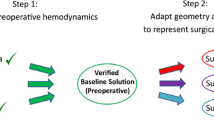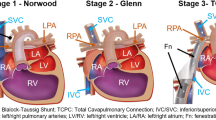Abstract
The Fontan procedure is a surgery that is performed on single-ventricle heart patients, and, due to the wide range of anatomies and variations among patients, lends itself nicely to study by advanced numerical methods. We focus on a patient-specific Fontan configuration, and perform a fully coupled fluid–structure interaction (FSI) analysis of hemodynamics and vessel wall motion. To enable physiologically realistic simulations, a simple approach to constructing a variable-thickness blood vessel wall description is proposed. Rest and exercise conditions are simulated and rigid versus flexible vessel wall simulation results are compared. We conclude that flexible wall modeling plays an important role in predicting quantities of hemodynamic interest in the Fontan connection. To the best of our knowledge, this paper presents the first three-dimensional patient-specific fully coupled FSI analysis of a total cavopulmonary connection that also includes large portions of the pulmonary circulation.
Article PDF
Similar content being viewed by others
Avoid common mistakes on your manuscript.
References
Bazilevs Y, Calo VM, Cottrel JA, Hughes TJR, Reali A, Scovazzi G (2007) Variational multiscale residual-based turbulence modeling for large eddy simulation of incompressible flows. Comput Methods Appl Mech Eng 197: 173–201
Bazilevs Y, Calo VM, Hughes TJR, Zhang Y (2008) Isogeometric fluid–structure interaction: theory, algorithms, and computations. Comput Mech 43: 3–37
Bazilevs Y, Calo VM, Zhang Y, Hughes TJR (2006) Isogeometric fluid–structure interaction analysis with applications to arterial blood flow. Comput Mech 38: 310–322
Bazilevs Y, Gohean JR, Hughes TJR, Moser RD, Zhang Y (2009) Patient-specific isogeometric fluid–structure interaction analysis of thoracic aortic blood flow due to implantation of the Jarvik 2000 left ventricular assist device. Comput Methods Appl Mech Eng. doi:10.1016/j.cma.2009.04.015
Bazilevs Y, Hsu M-C, Zhang Y, Wang W, Liang X, Kvamsdal T, Brekken R, Isaksen JG (2009) A fully-coupled fluid–structure interaction simulation of cerebral aneurysms. Comput Mech, In the same issue
Bischoff M, Wall WA, Bletzinger K-U, Ramm E (2004) Models and finite elements for thin-walled structures. In: Stein E, de Borst R, Hughes TJR (eds) Encyclopedia of computational mechanics, vol 2, Solids, structures and coupled problems, chap 3. Wiley
Bove EL, de Leval MR, Migliavacca F, Guadagni G, Dubini G (2003) Computational fluid dynamics in the evaluation of hemodynamic performance of cavopulmonary connections after the Norwood procedure for hypoplastic left heart syndrome. J Thorac Cardiovasc Surg 126: 1040–1047
Chung J, Hulbert GM (1993) A time integration algorithm for structural dynamics with improved numerical dissipation: the generalized-α method. J Appl Mech 60: 371–375
de Leval MR, Dubini G, Migliavacca F, Jalali H, camporini G, Redington A, Pietrabissa R (1996) Use of computational fluid dynamics in the design of surgical procedures: application to the study of competitive flows in cavo-pulmonary connections. J Thorac Cardiovasc Surg 111(3): 502–513
Dubini G, de Leval MR, Pietrabissa R, Montevecchi FM, Fumero R (1996) A numerical fluid mechanical study of repaired congenital heart defects: application to the total cavopulmonary connection. J Biomech 29(1): 111–121
Ensley AE, Ramuzat A, Healy TM, Chatzimavroudis GP, Lucas C, Sharma S, Pettigrew R, Yoganathan AP (2000) Fluid mechanic assessment of the total cavopulmonary connection using magnetic resonance phase velocity mapping and digital particle image velocimetry. Ann Biomed Eng 28: 1172–1183
Farhat C, Geuzaine P, Grandmont C (2001) The discrete geometric conservation law and the nonlinear stability of ALE schemes for the solution of flow problems on moving grids. J Comput Phys 174(2): 669–694
Fontan F, Baudet E (1971) Surgical repair of tricuspid atresia. Thorax 26: 240–248
Giardini A, Balducci A, Specchia S, Gaetano G, Bonvicini M, Picchio FM (2008) Effect of sildenafil on haemodynamic response to exercise capacity in fontan patients. Eur Heart J 29: 1681–1687
Hjortdal VE, Emmertsen K, Stenbog E, Frund T, Rahbek Schmidt M, Kromann O, Sorensen K, Pedersen EM (2003) Effects of exercise and respiration on blood flow in total cavopulmonary connection: a real-time magnetic resonance flow study. Circulation 108: 1227–1231
Holzapfel GA (2000) Nonlinear solid mechanics, a continuum approach for engineering. Wiley, Chichester
Hughes TJR (2000) The finite element method: linear static and dynamic finite element analysis. Dover Publications, Mineola
Hughes TJR, Liu WK, Zimmermann TK (1981) Lagrangian- Eulerian finite element formulation for incompressible viscous flows. Comput Methods Appl Mech Eng 29: 329–349
Isaksen JG, Bazilevs Y, Kvamsdal T, Zhang Y, Kaspersen JH, Waterloo K, Romner B, Ingebrigtsen T (2008) Determination of wall tension in cerebral artery aneurysms by numerical simulation. Stroke 39: 3172–3178
Jansen KE, Whiting CH, Hulbert GM (1999) A generalized-α method for integrating the filtered Navier-Stokes equations with a stabilized finite element method. Comput Methods Appl Mech Eng 190: 305–319
Johnson AA, Tezduyar TE (1994) Mesh update strategies in parallel finite element computations of flow problems with moving boundaries and interfaces. Comput Methods Appl Mech Eng 119: 73–94
Khunatorn Y, Mahalingam S, DeGroff CG, Shandas R (2002) Influence of connection geometry and SVC-IVC flow rate ratio on flow structures within the total cavopulmonary connection: a numerical study. J Biomech Eng Trans ASME 124: 364–377
Kulik TJ, Bass JL, Fuhrman BP, Moller JH, Lock JE (1983) Exercise induced pulmonary vasoconstriction. Br Heart J 50: 59–64
Marsden AL, Vignon-Clementel IE, Chan F, Feinstein JA, Taylor CA (2007) Effects of exercise and respiration on hemodynamic efficiency in CFD simulations of the total cavopulmonary connection. Ann Biomed Eng 35(2): 250–263
Marsden AL, Bernstein AD, Reddy VM, Shadden S, Spilker R, Chan FP, Taylor CA, Feinstein JA (2009) Evaluation of a novel Y-shaped extracardiac fontan baffle using computational fluid dynamics. J Thorac Cardiovasc Surg, To appear
Marsden AL, Vignon-Clementel IE, Chan F, Feinstein JA, Taylor CA (2007) Effects of exercise and respiration on hemodynamic efficiency in CFD simulations of the total cavopulmonary connection. Ann Biomed Eng 35: 250–263
Masters JC, Ketner M, Bleiweis MS, Mill M, Yoganathan A, Lucas CL (2004) The effect of incorporating vessel compliance in a computational model of blood flow in a total cavopulmonary connection (tcpc) with caval centerline offset. J Biomech Eng 126: 709–713
Migliavacca F, Dubini G, Bove EL, de Leval MR (2003) Computational fluid dynamics simulations in realistic 3-D geometries of the total cavopulmonary anastomosis: the influence of the inferior caval anastomosis. J Biomech Eng 125: 805–813
Migliavacca F, Dubini G, Pietrabissa R, de Leval MR (1997) Computational transient simulations with varying degree and shape of pulmonic stenosis in models of the bidirectional cavopulmonary anastomosis. Med Eng Phys 19: 394–403
Pedersen EM, Stenbog EV, Frund T, Houlind K, Kromann O, Sorensen KE, Emmertsen K, Hjortdal VE (2002) Flow during exercise in the total cavopulmonary connection measured by magnetic resonance velocity mapping. Heart 87: 554–558
Petrossian E, Reddy VM, Collins KK, Culbertson CB, MacDonald MJ, Lamberti JJ, Reinhartz O, Mainwaring RD, Francis PD, Malhotra SP, Gremmels DB, Suleman S, Hanley FL (2006) The extracardiac conduit Fontan operation using minimal approach extracorporeal circulation: early and midterm outcomes. J Thorac Cardiovasc Surg 132(5): 1054–1063
Sahni O, Muller J, Jansen KE, Shephard MS, Taylor CA (2006) Efficient anisotropic adaptive discretization of the cardiovascular system. Comput Methods Appl Mech Eng 195: 5634–5655
Shachar GB, Fuhrman BP, Wang Y, Lucas RV Jr, Lock JE (1982) Rest and exercise hemodynamics after the fontan procedure. Circulation 65: 1043–1048
Stein K, Tezduyar T, Benney R (2003) Mesh moving techniques for fluid–structure interactions with large displacements. J Appl Mech 70: 58–63
Stein K, Tezduyar TE, Benney R (2004) Automatic mesh update with the solid-extension mesh moving technique. Comput Methods Appl Mech Eng 193: 2019–2032
Takizawa K, Christopher J, Moorman C, Martin J, Purdue J, McPhail T, Chen PR, Warren J, Tezduyar TE (2009) Space-time finite element computation of arterial FSI with patient-specific data. In: Schrefler B, Onate E, Papadrakakis M (eds) Computational methods for coupled problems in science and engineering, coupled problems 2009
Takizawa K, Christopher J, Tezduyar TE, Sathe S (2009) Space-time finite element computation of arterial fluid–structure interactions with patient-specific data. Commun Numer Methods Eng, published online. doi:10.1002/cnm.1241
Tezduyar TE, Aliabadi S, Behr M, Johnson A, Mittal S (1993) Parallel finite element computation of 3D flows. Computer 26: 27–36
Tezduyar TE (2003) Computation of moving boundaries and interfaces and stabilization parameters. Int J Numer Methods Fluids 43: 555–575
Tezduyar TE, Behr M, Mittal S, Johnson AA (1992) Computation of unsteady incompressible flows with the stabilized finite element methods—space-time formulations, iterative strategies and massively parallel implementations. In: New methods in transient analysis, PVP-Vol. 246/ AMD-Vol. 143, pp 7–24. ASME, New York
Tezduyar TE, Sathe S (2007) Modelling of fluid–structure interactions with the space-time finite elements: solution techniques. Int J Numer Methods Fluids 54: 855–900
Tezduyar TE, Sathe S, Cragin T, Nanna B, Conklin BS, Pausewang J, Schwaab M (2007) Modelling of fluid–structure interactions with the space-time finite elements: arterial fluid mechanics. Int J Numer Methods Fluids 54: 901–922
Tezduyar TE, Sathe S, Keedy R, Stein K (2006) Space-time finite element techniques for computation of fluid–structure interactions. Comput Methods Appl Mech Eng 195: 2002–2027
Tezduyar TE, Sathe S, Schwaab M, Conklin BS (2008) Arterial fluid mechanics modeling with the stabilized space-time fluid–structure interaction technique. Int J Numer Methods Fluids 57: 601–629
Tezduyar TE, Schwaab M, Sathe S (2008) Sequentially-coupled arterial fluid–structure interaction (SCAFSI) technique. Comput Methods Appl Mech Eng, published online. doi:10.1016/j.cma.2008.05.024
Torii R, Oshima M, Kobayashi T, Takagi K, Tezduyar TE (2006) Computer modeling of cardiovascular fluid–structure interactions with the deforming-spatial-domain/stabilized space-time formulation. Comput Methods Appl Mech Eng 195: 1885–1895
Torii R, Oshima M, Kobayashi T, Takagi K, Tezduyar TE (2006) Fluid–structure interaction modeling of aneurysmal conditions with high and normal blood pressures. Comput Mech 38: 482–490
Torii R, Oshima M, Kobayashi T, Takagi K, Tezduyar TE (2008) Fluid–structure interaction modeling of a patient-specific cerebral aneurysm: influence of structural modeling. Comput Mech 43: 151–159
Torii R, Oshima M, Kobayashi T, Takagi K, Tezduyar TE (2009) Influence of wall thickness on fluid–structure interaction computations of cerebral aneurysms. Commun Numer Methods Eng, published online. doi:10.1002/cnm.1289
Vignon-Clementel IE, Figueroa CA, Jansen KE, Taylor CA (2006) Outflow boundary conditions for three-dimensional finite element modeling of blood flow and pressure in arteries. Comput Methods Appl Mech Eng 195: 3776–3796
Zhang Y, Wang W, Liang X, Bazilevs Y, Hsu M-C, Kvamsdal T, Brekken R, Isaksen JG (2009) High-fidelity tetrahedral mesh generation from medical imaging data for fluid–structure interaction analysis of cerebral aneurysms. Comput Model Eng Sci 42: 131–149
Acknowledgments
We wish to thank the Texas Advanced Computing Center (TACC) at the University of Texas at Austin for providing HPC resources that have contributed to the research results reported within this paper. Support of Teragrid Grant No.MCAD7S032 is gratefully acknowledged. Alison Marsden was supported by a Burroughs Wellcome Fund Career Award at the Scientific Interface, and by an American Heart Association Beginning Grant in Aid award.We would also like to thank Jeff Feinstein for his valuable input on the clinical relevance of the reported simulations.
Open Access
This article is distributed under the terms of the Creative Commons Attribution Noncommercial License which permits any noncommercial use, distribution, nand reproduction in any medium, provided the original author(s) and source are credited.
Author information
Authors and Affiliations
Corresponding author
Rights and permissions
Open Access This is an open access article distributed under the terms of the Creative Commons Attribution Noncommercial License (https://creativecommons.org/licenses/by-nc/2.0), which permits any noncommercial use, distribution, and reproduction in any medium, provided the original author(s) and source are credited.
About this article
Cite this article
Bazilevs, Y., Hsu, MC., Benson, D.J. et al. Computational fluid–structure interaction: methods and application to a total cavopulmonary connection. Comput Mech 45, 77–89 (2009). https://doi.org/10.1007/s00466-009-0419-y
Received:
Accepted:
Published:
Issue Date:
DOI: https://doi.org/10.1007/s00466-009-0419-y




